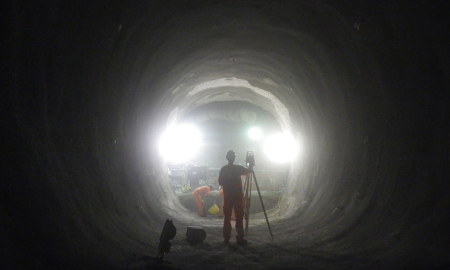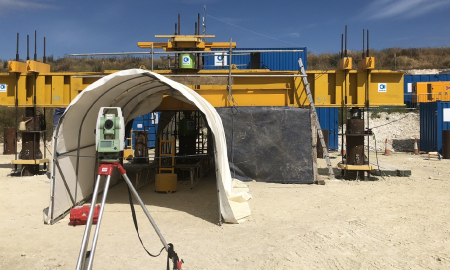The use of a Falling Weight Deflectometer in Road Pavement Investigation
Understanding the structural integrity of the UK’s highway infrastructure is critical to pavement construction and central to the design and optimisation of highway maintenance. Here Tom Green, technical manager, discusses non-destructive testing and the valuable insight these test methods provide to civil engineers.
Here Tom Green, technical manager, discusses non-destructive testing and the valuable insight these test methods provide to civil engineers.
Traditionally, foundation design of paved infrastructure followed a prescriptive approach. However, in 2009, to encourage sustainability, the UK Highways Agency launched new pavement and foundation design guidance (IAN 73/06 revised in 2009, and HA 26/06). The design guidance allowed a more flexible design and assessment of the required foundation performance parameters of strength and resistance to permanent deformation.
Benefits of a Performance Based Method
Unlike the traditional prescriptive approach, the performance based method enables the foundation performance to influence the design of the structural pavement layers above. Non-destructive testing (NDT) methods are the most widely used methods of assessing the performance of new pavement foundations and assessing the integrity of existing pavements., Dynamic plate test devices, such as the falling weight deflectometer (FWD) and lightweight deflectometer (LWD) are the best suited. Generally speaking the LWD is used to assess unbound materials, with the FWD being more suited to bound materials. Correlations between the two devices can be performed in accordance with BS1924:2018 providing traceability of LWD results.
Identifying Pavement Characteristics
In order to undertake field assessments of the pavement performance, an FWD mimics the loading of heavy traffic and measures the response to that load. It is used to undertake a non-destructive test to identify pavement characteristic sections and predict in-situ layer stiffness.
The properties identified by the FWD can include:
- Areas of good or poor performance
- Cracking (even in sub surface layers)
- Effect of utilities trenches
- Bound material performance
- Foundation performance
- Performance and load transfer properties of joints in concrete pavements and industrial floors
- Detection of under slab voiding
- Surface modulus of foundation and subgrade layers without excavation
In simple terms, the FWD works by raising and dropping a weight onto the pavement by either hydraulic or electromechanical means. The weight falls on rubber buffers that transfer the load at a controlled rate to a plate resting on the pavement. Typically, the load for highways pavement testing is 50kN giving about 700kPa pressure under the load plate. The FWD used by SOCOTEC, in heavy weight deflectometer (HWD) configuration, can apply loads of up to 250kN (>3500kPa), making it suitable for use on road pavements as well as heavy duty industrial sites and airport runways. The deflection of the pavement surface at the center of the plate and at various radial locations is measured to an accuracy of 1µm.
The impact load causes the pavement to deflect, closely approximating how the pavement deflects when a vehicle passes over it. The applied load pulse generates a deflection basin with the deflections becoming smaller further from the load plate. A series of sensors measure the level of pavement deflection. The data produced by the FWD is hugely powerful and can help engineers to design a robust road structure as well as helping to plan more efficient repairs by detecting areas of poor integrity and cracking. Often overlooked for used on local “evolved” roads FWD can be used to verify patching locations, and identify areas of potential future failure that would not be identified by visual assessment alone. This approach complements the current requirements for asset management as described in the “Well-managed Highway Infrastructure” code of practice.
Design and Maintenance
SOCOTEC provides a full package of pavement investigation services to support civil engineers in pavement design and maintenance. For example, for junction 8 of the M25 road improvement scheme, SOCOTEC conducted pavement investigations to provide information on the condition of the underlying made ground. Using diamond core drilling, unbound material sampling (UMS), falling weight deflectometer (FWD) testing and ground penetrating radar (GPR) SOCOTEC was able to provide descriptions of the materials encountered and details of the samples taken, together with observations made during the work.
The pavement core samples were tested at SOCOTEC’s Weymouth laboratory, with tests including PAK marker screening for polycyclic aromatic hydrocarbons (PAHs), bulk density, maximum density and air voids content in addition to indirect tensile stiffness modulus testing.
A further use of the FWD was on a small highway maintenance scheme, where the initial design was for patching followed by surface dressing. The patching locations had already been established based on visual condition. SOCOTEC was asked to provide verification of the design with FWD testing and interpretation of the resulting deflection profiles. The results of the testing showed significant weakness throughout the bound construction of the whole site, rather than just the identified areas that were visually deteriorating. These additional areas would have required further patching within only a few years. As a result the client redesigned the scheme and identified a significant cost saving of over £30k on a scheme of only 400m in length.
SOCOTEC has also used the FWD to provide information relating to areas of concrete hard standing within an industrial area. The concrete pavement was evolved rather than designed, and as such no construction information was available. The FWD was used for assessment of the load transfer properties of the joints, as well as void intercept testing to establish the presence of voiding beneath the slab. Diamond drilling and dynamic cone penetrometer (DCP) testing were carried out to establish thickness of layers and compressive strength of the concrete specimens. This data was interpreted to provide reassurance that the existing construction was suitable for it proposed new use.
Other Non-destructive Tests
Without coring or digging, the FWD and other non-destructive tests can provide civil engineers and contractors the information they need on the condition of the road pavement and underlying layers, allowing more informed decisions to be made on design, repair and maintenance.
Other complimentary pavement investigations offered by SOCOTEC include:
- Ground Penetrating Radar (GPR)
- Coring Survey, Dynamic Cone Penetrometer (DCP) Unbound Material Sampler (UMS)
- Griptester
- Deflectograph
- Visual Condition Survey (VCS).
SOCOTEC can offer complimentary combined packages of geotechnical site investigation, pavement investigation, utilities mapping and structural assessment, all with in-house capability. This unique collaborative approach allows a reduction in subcontractors required to complete a scheme, as well as huge savings through reduced programme.






Add new comment